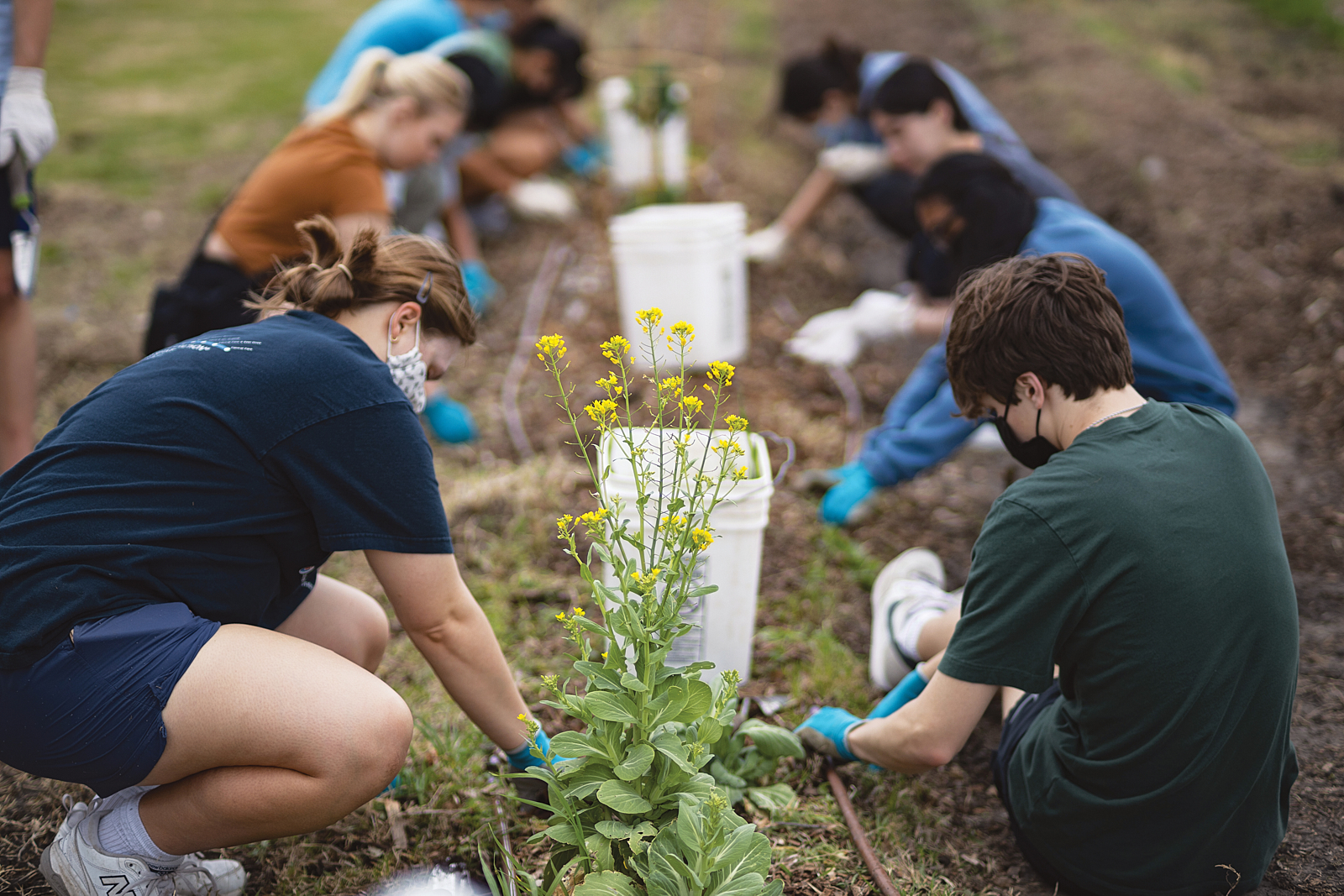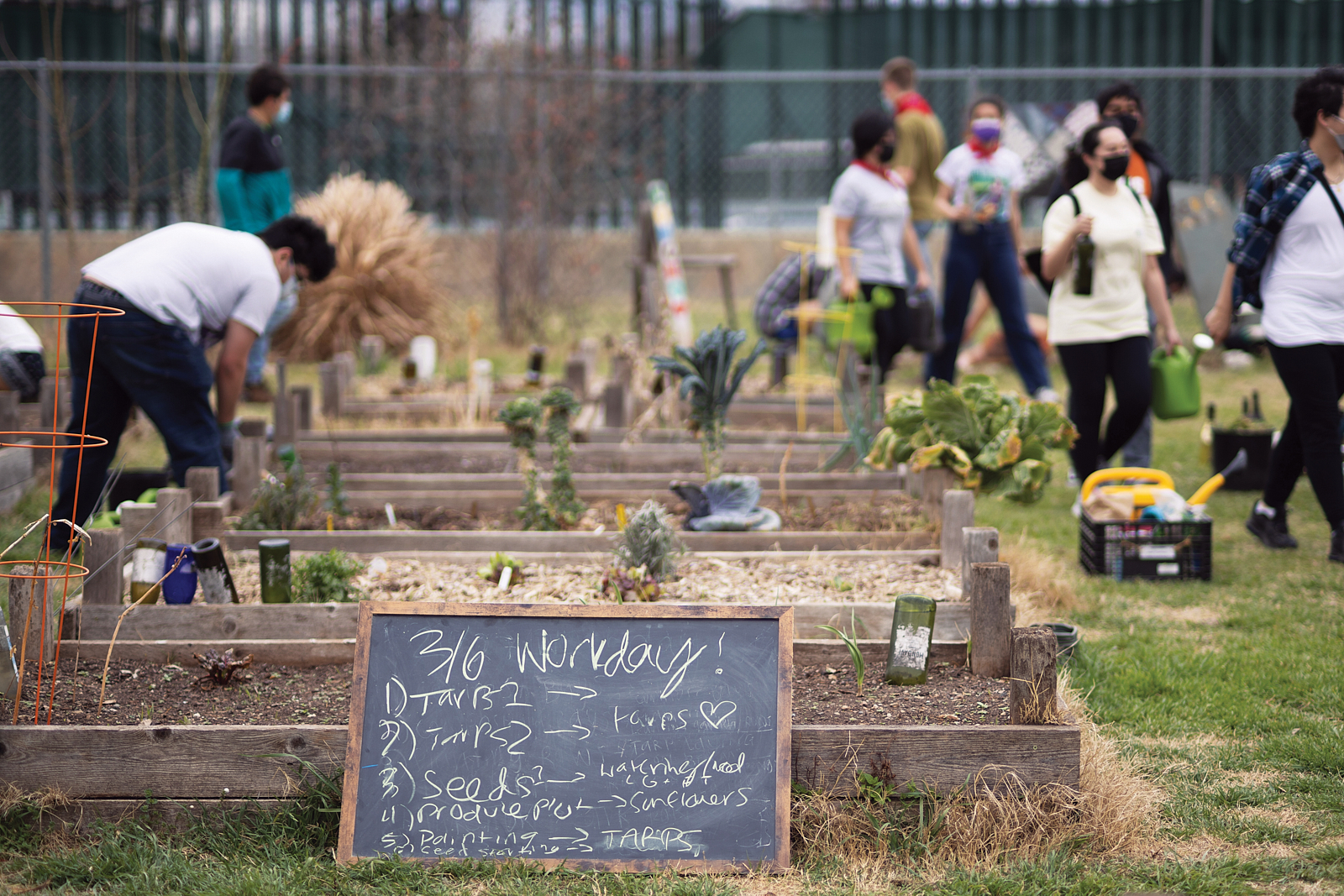UT’s Student-Run Microfarm Is Celebrating Its 10th Anniversary—and a New Period of Growth

On a recent early spring day behind the tennis courts at UT’s Wright-Whitaker Sports Complex, there’s more to be found than rogue balls and dry grass along the tree line. Instead, there’s a compost pile, rows of planted seeds covered with protective tarps, two sheds, and neatly maintained plots with reused wine bottles standing upside down in the soil, providing much-needed water to their growing seedlings.
And every Sunday morning, you’ll find a group of volunteer students getting their hands in the dirt, working to maintain the university’s microfarm and growing a variety of fruits and vegetables.
The microfarm, which is a fifth of an acre, is UT’s first student-run, organic urban farm. It’s managed by the Campus Environmental Center and was founded in 2012 at a site just east of the Forty Acres on Leona Street. In the beginning, the microfarm’s veggies were sold at a low cost or given to the student volunteers. But when the farm moved to its current location at the intramural fields in 2018, its mission changed a little. Now, all the produce grown by students goes to other students in need through UT Outpost, the campus food pantry.
“Our purpose now is to give fresh organic produce to students who may not otherwise have access to it, as well as to provide volunteer opportunities and educational opportunities for students. They get to experience agriculture at a school that really isn’t an agricultural school—we’re in the middle of Austin,” says Nikki Hammond, one of two student co-leads at the microfarm. “It’s a pocket of something unique here.”

On this workday in early March, the students are busy replanting the field, ripping up old tarp, and weeding around the field and plots. Hammond is directing her crew of around 50 students—splitting them into groups, pointing out tasks, and pulling her trusty pocket knife out of her overalls to cut holes into tarps for new seeds. She makes sure there is appropriate room between each soon-to-be zucchini or leafy green or squash.
The microfarm looks a little bare at the moment, but not for long. It’s currently recovering from a long period of neglect during the coronavirus pandemic, when students weren’t allowed to volunteer in person. The students were getting ready for their first big harvest on the new site in March 2020 when campus was suddenly shut down.
Luckily, they found a way to make sure all the produce—and their hard work—didn’t go to waste. Brianna Duran, a program coordinator with the Campus Environmental Center, was able to complete the harvest on her own.
“We put in a special request to RecSports, so that at least I could go out there and harvest the vegetables, because we just felt like during this time of crisis, we shouldn’t be letting food rot out in the fields,” Duran says. “I was out there every week or so harvesting lettuce and onions and those sorts of things … and trucking that stuff down to the Central Texas Food Bank so that they could use the vegetables.” Duran was eventually able to donate nearly 150 pounds of food.
But after that, they could only bring out very small groups of volunteers until August 2021, and until now, the focus has mainly been on readying the microfarm for planting again by ripping out overgrowth and tilling the soil.

“This year, we really haven’t focused that much on crop productivity, which is ironic, because it’s a farm,” Hammond says. “We had to focus on getting the trees out of where we were planting things before we could get a restart with the planting process.”
The planting process is where the magic really happens, when the students—many of whom have no gardening experience—get to learn to grow their own food and see the literal fruits of their labor a few months later. For Hammond, Duran, and the others, it’s an almost indescribable feeling.

“There is something about pulling potatoes out of the ground,” Duran says. “Those are the kinds of moments that the microfarm provides to students, just that connection and the joy that is being outside and being with your friends, doing good work, being hands-on ... The great thing about gardening is that growth piece, right? Like you get to plant something and then come back a month later and see a carrot. It’s a really, really cool experience for anybody.”
And to Hammond, the microfarm really is a place of magic, whether it’s in need of some care or overflowing with vegetables.
“There’s just something to the process of it. There’s something to the group of people. There’s something to the community that’s built through farming,” Hammond says. “I call it the ‘microfarm magic.’ People who come out here want to come back. I feel like it’s the place itself that draws you back.”
Credit: Summer Miles (3)





